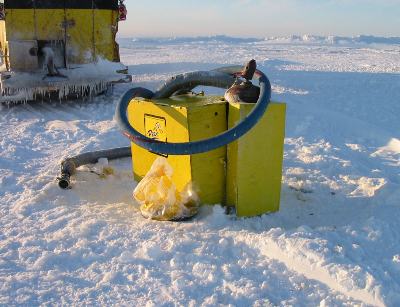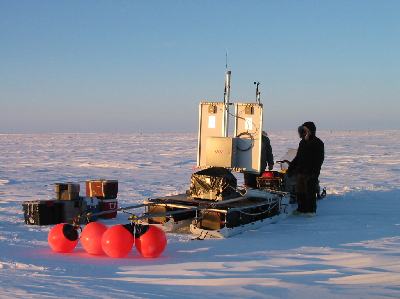Physical, Biological and Chemical Implications of Mid-Winter Pumping of Tundra Lakes
|
Introduction
Welcome to the Water and Environmental Research Center's Tundra Lake Recharge Project Web site. This site contains hydrologic information of tundra lakes on the North Slope of Alaska. This information is used by University of Alaska Researchers and other Project Cooperators to assess the physical,chemical and biological implications of mid-winter pumping of tundra lakes. Data on this Web site as well as results from the ongoing study are available to the public at large to promote understanding of development activities on the North Slope, their effects on the hydrology of tundra lakes, and actions taken to reduce impacts to the local ecosystem.
Background
For many years, the oil industry and support services have built ice roads and pads for increased access to remote sites with decreased maintenance costs. This technique is quite important to the oil industry in that it allows oil field development or maintenance while avoiding the environmental disturbance associated with construction of gravel roads and pads. Construction on ice-roads and pads begins in December or January when the tundra mat is adequately frozen to support construction traffic and continues through April (depending upon weather). Recently numerous questions have been raised regarding the potential environmental consequences of such pumping. Possible effects of pumping include impacts to the water balance, impacts to aquatic organisms (including fish and invertebrates), and impacts to the lake water chemistry.
In the Fall of 2002 the University of Alaska Fairbanks Water and Environmental Research Center, together with other project cooperators, initiated a study to obtain baseline information about the physical, biological, and chemical characteristics of tundra lakes in order to help assess some of the major questions related to winter pumping of lakes. Data from the project is available to the public on this web site. Automated data collection stations on lakes provide 15-minute data which is updated on the dominate at hourly intervals. This project is funded in part by the U.S. Department of Energy through a grant provided by the University of Alaska Fairbanks Arctic Energy Technology Development Laboratory.Additional funding is provided by project cooperators in the form of financial and in-kind match.
Description of Methods
We have established four lake stations that continuously monitor lake conditions such as water levels, lake temperature profiles, and electrical conductivity. Two of these stations are in lakes that are pumped during winter and two are in non-pumped, control lakes. The lakes are located within the Kuparuk Oil Field operating area (See Map). These lake stations together with neighboring meteorological stations operated by the University of Alaska will provide data necessary to calculate a water balance for the lakes, including evaporative and condensation water fluxes. During spring-melt and summer, we intend to monitor influx and outflows (streams entering or leaving lakes, groundwater flux, vertical flux through evaporation and condensation) on select lakes. We will monitor the changes in lake water volume during pumping while we monitor various chemical and physical properties. The volume removed during pumping will be verified with field measurements of lake volume change. We will quantify spring snowpack water equivalent and lake watershed area to enable hydrological modeling analyses. Lake chemistry will be evaluated prior to spring melt, post spring melt, monthly during the summer, prior to pumping and after of pumping. Constituents monitored include macronutrients, basic cations and anions, and alkalinity, pH, DO.
 Pumping of Water in Lake K209 |
 Installation of Monitoring Station on Lake K209 |